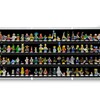Automatic Edge Banding Machine: Revolutionizing Woodworking and Furniture Manufacturing
In the modern woodworking and furniture manufacturing industry, Automatic Edge Banding Machine play a vital role in ensuring precision, efficiency, and high-quality finishes. These machines automate the process of applying edge banding material to the exposed edges of wood-based panels, such as plywood, MDF, particle board, and veneer. By automating this process, manufacturers can significantly enhance production speed, consistency, and overall product quality.
In this article, we’ll explore the features, types, and benefits of automatic edge banding machines, their working principles, and their growing role in modern manufacturing.
What is an Automatic Edge Banding Machine?
An Automatic Edge Banding Machine is a fully automated device used in woodworking and furniture manufacturing to apply edge banding to the edges of panels. These machines are designed to handle the entire process—from panel feeding, edge banding application, trimming, to finishing—without requiring manual intervention.
The machine uses various tools and systems to ensure that the edge banding material is applied precisely and consistently across different panel sizes. Automatic edge banding machines are especially beneficial in mass production settings where speed, accuracy, and uniformity are critical.
Key Components of an Automatic Edge Banding Machine
Automatic edge banding machines come with a range of components designed to streamline the banding process and enhance efficiency:
- Automatic Panel Feeding System
- The automatic feeding system ensures that panels are aligned and fed into the machine without manual intervention. This system uses belts, rollers, or chains to transport the panels.
- Edge Banding Applicator
- The edge banding material is applied to the panel edges using hot-melt adhesive or cold glue. The applicator ensures a consistent, even layer of adhesive and banding material across the edge.
- Pre-Milling Unit
- Before applying the edge banding, the pre-milling unit trims and smooths the panel edges, removing any rough or uneven surfaces. This step ensures that the bond between the edge banding and the panel is secure and smooth.
- End Cutting and Cross Cutting Units
- These units trim any excess edge banding material at the panel’s ends and sides to ensure that the banding fits perfectly along the edges.
- Corner Rounding and Scraping Units
- The corner rounding units smooth out sharp edges, providing a professional finish. The scraping units remove any excess adhesive from the surface of the panel, ensuring a clean and neat look.
- Buffing and Polishing Units
- These units polish the edges to give them a smooth and high-quality finish. Buffing ensures the edge banding is flawless, with no visible marks or imperfections.
- Control Panel
- The control panel is the heart of the machine, allowing operators to set various parameters such as feed speed, edge banding thickness, adhesive temperature, and machine settings. Many modern machines come with touchscreen interfaces for easy adjustments.
- Dust Extraction System (Optional)
- Many machines come with an integrated dust extraction system to maintain cleanliness during the operation, removing any wood dust or debris that might accumulate in the process.
How Does an Automatic Edge Banding Machine Work?
An automatic edge banding machine automates the entire process of edge banding, which includes several steps:
1. Panel Feeding
- Panels are automatically fed into the machine, where they are positioned precisely for edge banding. Sensors or guides ensure that the panel is aligned correctly for uniform banding.
2. Pre-Milling
- The pre-milling unit trims the edges of the panel, ensuring they are smooth and free of imperfections. This ensures that the edge banding material adheres perfectly.
3. Edge Banding Application
- The edge banding material, such as PVC, ABS, melamine, or wood veneer, is fed into the machine. The material is applied to the edge of the panel using hot-melt adhesive, which is applied using a glue pot or roller system. In some cases, cold glue systems are used for certain types of materials.
4. Trimming
- After the edge banding material is applied, the machine uses end cutting and cross-cutting tools to remove excess banding, ensuring a flush and smooth finish along the edges of the panel.
5. Scraping and Rounding
- The excess adhesive is scraped off, and the corners of the banded edges are rounded to give the panel a smooth, polished finish. Some machines may also perform radius rounding for added aesthetic appeal.
6. Buffing and Polishing
- Finally, the edges are buffed and polished to achieve a clean and professional finish. This step ensures that the edge banding is flawless and smooth, providing a high-quality product.
Types of Automatic Edge Banding Machines
There are several types of automatic edge banding machines, each suited for different production needs and scale:
1. Single-Sided Automatic Edge Banding Machines
- These machines apply edge banding to only one side of the panel. They are ideal for smaller-scale operations or less complex panel processing needs.
- Applications: Small to medium-sized workshops, custom furniture manufacturing.
2. Double-Sided Automatic Edge Banding Machines
- These machines apply edge banding to both sides of the panel in a single pass, increasing efficiency and productivity. They are designed for mass production environments.
- Applications: Large-scale furniture manufacturers, industrial cabinet makers.
3. Fully Automatic Edge Banding Machines
- These machines are equipped with a variety of automated features, such as automatic panel feeding, edge banding material application, trimming, and finishing. They are designed for high-volume production and can handle a wide range of panel sizes and edge materials.
- Applications: High-volume, large-scale industrial manufacturers.
4. CNC Automatic Edge Banding Machines
- These machines integrate CNC technology, providing highly precise edge banding with the ability to process complex and customized panel designs. These machines offer flexibility and precision for intricate edge profiles and custom furniture.
- Applications: High-end custom furniture makers, manufacturers requiring precise and detailed edge banding.
5. Compact Automatic Edge Banding Machines
- These are smaller machines designed for workshops or companies that may not have the space for larger machines but still need automation for high-quality edge banding.
- Applications: Small-to-medium-sized woodworking shops or custom furniture manufacturers.
Benefits of Automatic Edge Banding Machines
1. Increased Productivity
- By automating the edge banding process, manufacturers can achieve higher output levels, reducing labor costs and increasing production efficiency.
2. Consistent Quality
- Automatic edge banding machines ensure a uniform and precise application of edge banding material, which results in high-quality finishes and minimal defects.
3. Faster Turnaround Times
- Automated machines operate at much higher speeds than manual processes, allowing manufacturers to complete large orders in less time.
4. Reduced Labor Costs
- Automation reduces the need for manual labor in the edge banding process, cutting down on staffing requirements and associated costs.
5. Customization Options
- Many automatic edge banding machines can handle various edge materials and thicknesses, allowing manufacturers to customize their products to meet specific customer needs.
6. Improved Safety
- Automated systems reduce human interaction with moving parts, minimizing the risk of accidents or injuries during production.
7. Energy Efficiency
- Many modern automatic edge banding machines are designed to be energy-efficient, using less power and reducing operational costs.
Applications of Automatic Edge Banding Machines
Automatic edge banding machines are used in a wide range of industries, including:
- Furniture Manufacturing: Automatic edge banding is used to apply edge banding to furniture panels, such as tables, cabinets, and chairs.
- Cabinet Making: Cabinet manufacturers rely on automatic edge banding to create uniform, high-quality edges for kitchen, bathroom, and other cabinetry.
- Interior Design: Automatic edge banding machines are used in the production of interior components like wall panels, flooring, and decorative pieces.
- Commercial Furniture: For large-scale production of office furniture, retail fixtures, and institutional furniture, automatic edge banding ensures a seamless finish and high durability.
Conclusion
Automatic edge banding machines are a game-changer for modern woodworking and furniture manufacturing. By automating the edge banding process, these machines offer unmatched precision, efficiency, and quality, which are crucial for meeting the demands of high-volume production environments.
Whether for a small workshop or a large-scale industrial operation, the right automatic edge banding machine can drastically improve production times, reduce costs, and enhance product quality. As technology advances, automatic edge banding machines continue to evolve, incorporating features like energy efficiency, smart automation, and greater versatility to meet the diverse needs of the market.
If you are in the woodworking or furniture manufacturing industry, investing in an automatic edge banding machine could be a significant step toward increasing productivity and improving the quality of your products.



